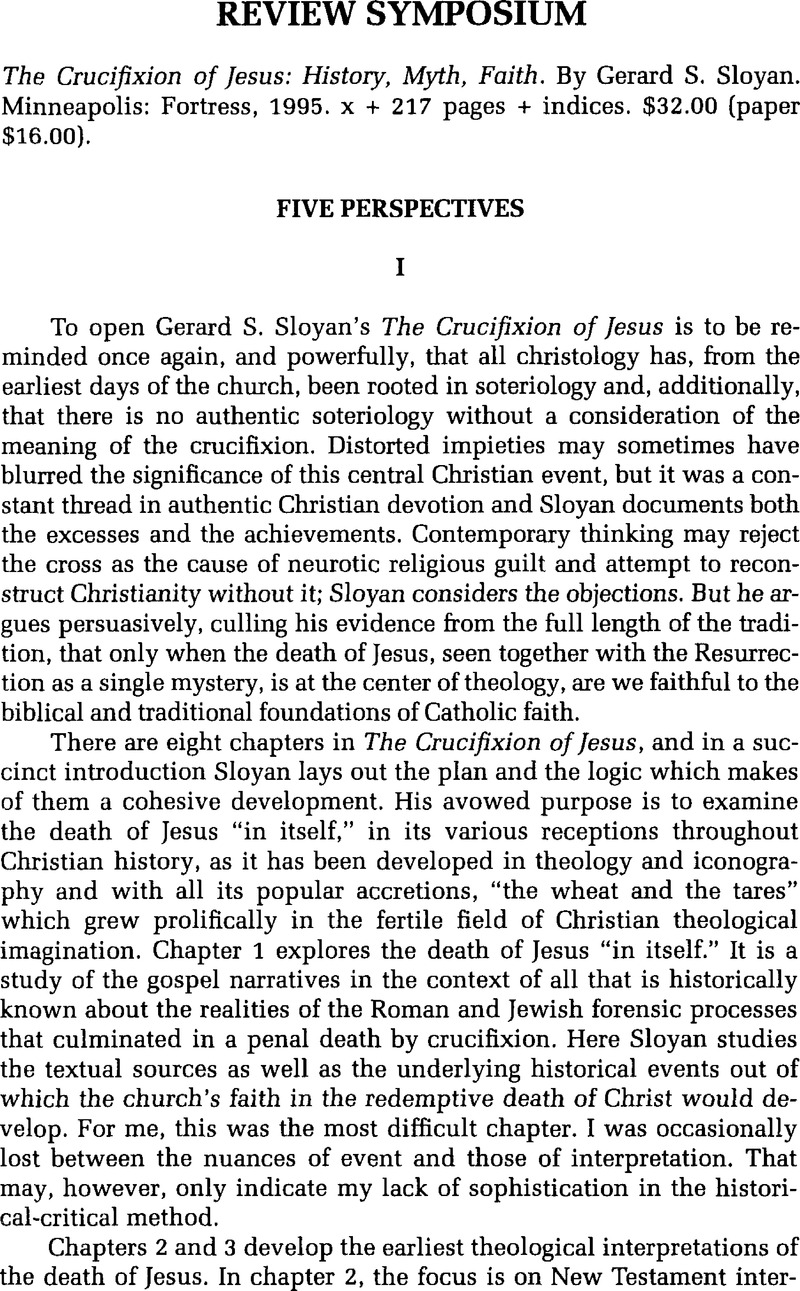No CrossRef data available.
Published online by Cambridge University Press: 09 September 2014

1 I am reliably told that the production cost of hardbacks exceeds that of softcovers by one dollar, even though they sell for about ten dollars more. Talk about gravy!
2 Walsh, Michael, The Triumph of the Meek. Why Early Christianity Succeeded (San Francisco: Harper & Row, 1986).Google Scholar
3 In fact, in 361 A.D., in a letter to Arsacius, High Priest of Galatia, Julian “the Apostate” could complain that his efforts to reinstate the old state religion, while successful beyond anything anyone could have prayed for, were still hampered by “the atheists'” (= Christians') habits of hospitality to strangers, of piety toward the graves of the dead, and of outward shows of holiness of life, adding that the officials of the state religion should be compelled to imitate the Christians' virtues; they should stop employing atheists as servants, frequenting theaters and taverns, and run businesses unworthy of their office. He finally gives instructions to make large amounts of corn and wine available for public distribution to travelers and poor people, and reminds Arsacius that Christians are taking care not only of “their own poor, but ours as well.” See The Works of the Emperor Julian, 3 vols., Loeb Classical Library (Cambridge: Harvard University Press, 1923), 3:66–73.Google Scholar
4 Raedts, Peter, “De christelijke middeleeuwen als mythe: Ontstaan en gebruik van een constructie uit de negentiende eeuw,” Tijdschrift voor Theologie 30 (1990): 146–58.Google Scholar
5 Incidentally, the Greek verb paschō, meaning “to suffer” is also the technical-juridical term for undergoing capital punishment. Thus it might be a good idea to replace “suffered, died, and was buried” in the English Creed by “was put to death and buried.” The latter phrase might then also help drive home the extraordinary fact that Jesus is the only crucified man known to us to receive a decent burial.
6 In his encyclical Ad beatissimi Apostolorum (ET AAS 6 [1914] 647-60) Pope Benedict XV, alluding to the then often-heard expression “integral Catholics,” wrote: “that practice, lately come into use, of using distinctive names by which Catholics are marked off from Catholics, should cease; such names must be avoided, not only as ‘profane novelties of words’ that are neither true not just, but also because they lead to grave disturbance and confusion in the Catholic body. It is of the nature of the Catholic faith that nothing can be added to it, nothing taken away;… There is no need to qualify by fresh epithets the profession of faith; let it be enough for a man to say: ‘Christian is my name, Catholic my surname’; only let him take heed to be in truth what he calls himself” (656-57).
7 This is not to deny that insisting on such historical knowledge as is de facto available is not a very sound theological posture. Thus, the new Catholic catechism's neglect (refusal?) to recognize the historical-critical method is very shortsighted, as Sloyan has well explained. Why discredit an intellectual venture that has opened the Scriptures to so many, including Cardinal Martini, as he has said of his own experience?
8 The suggestion is verified by passages like 1 Thess 1:6-10; 1 Tim 3:16e-f, where the acceptance of the apostolic preaching is interpreted as God's work as much as its content.
9 I am not so sure, however, that Sloyan's analysis of Anselm's argument in Cur Deus Homo is right. For present purposes, let me pass over his claim that “there is nothing of feudalism in Anselm's theorizing” (120). Instead, let me concentrate on the following. First of all, Sloyan writes that “the Anselmian formula of satisfaction [is] basically a compromise between the demand for punishment and the remission of punishment” (151). I must demur. Anselm clearly states that “either the [divine] honor taken away should be repaid, or punishment should be inflicted” [Cur Deus Homo 1: xiii). To cancel sin by a simple act of omnipotent indulgence would not be “just,” i.e., reasonable; such a gesture would treat sinners and sinless alike, and (it should be added) transform the whole human family to one big nursery where no one is morally responsible any more (see ibid. I: xii, in fine). Now God opts for satisfaction; there is going to be no punishment. And God achieves satisfaction by having Christ die for us, sinless though he is. But this is not all. The peak of the argument does not come until Cur Deus Homo 2: xx: “What greater mercy can be conceived than that God the Father should say to the sinner (condemned to eternal torment and unable to redeem himself), ‘Receive my only Son, and offer Him for thyself’ while the Son himself said, ‘Take me, and redeem thyself’?” At the conclusion of his analysis, in other words, Anselm appeals to the Eucharist. But this means that he is not just thinking of Christ's past self-offering of himself on the cross, but also on his present self-offering to God by sinners' hands. But this makes it unwarranted to say that Anselm has separated the death of Jesus from his resurrection. For the Christus praesens of medieval theology is the Eucharist. Bultmann is supposed to have said that Jesus rises into the kerygma—a dubious formula, but very true as long as the living Christ is not reduced to the kerygma. Anselm says something analogous: Jesus Christ rises into the Eucharistic Sacrifice. This idea has plenty of New Testament support, although it, too, must not be interpreted reductively. But to suggest that Anselm's Cur Deus Homo is an instance of the early medieval tendency to separate he crucifixion from the resurrection (215) does not do justice to Anselm's allusions to the Eucharist in Cur Deus Homo.